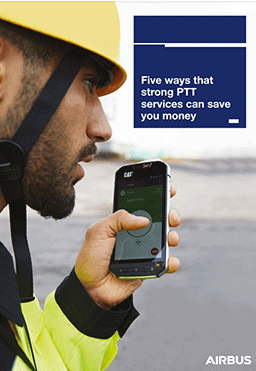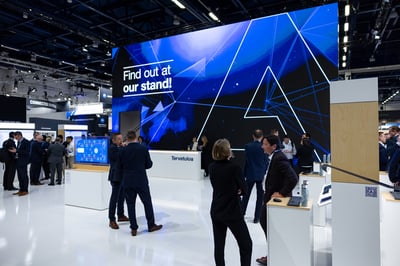Mission critical push-to-talk or MCPTT, is a familiar concept in radio communications. It means that you push a button and can instantly talk to your whole team or group. Mission critical broadband enables MCPTT in smart devices, too. Here are answers to the top questions people ask about mission critical PTT.The top 23 questions people ask– click on the question to be taken to the answer!
-
- What is push-to-talk? What is MCPTT?
- Why push-to-talk?
- Can a smartphone be used as a walkie-talkie?
- How to recognize a professional PTT app?
- Does push-to-talk come with video?
- Does push-to-talk use data?
- What are push-to-talk devices?
- Does a push-to-talk app work between iPhone/iOS and Android?
- Can a PTT app connect your smart device to a radio?
- What are push-to-talk accessories?
- How does push-to-talk work?
- How long does it take for a push-to-talk to connect?
- What are typical push-to-talk use cases?
- Does push-to-talk offer priority access for mission-critical communications?
- Is push-to-talk secure?
- How can we take push-to-talk into use?
- Can you use push-to-talk without internet?
- Does push-to-talk work over Wi-Fi?
- Does push-to-talk work without service?
- What is the range of push-to-talk?
- What frequency does push-to-talk use?
- Is it possible to develop a customized MCPTT application?
- Where are push-to-talk servers located?
1. What is push-to-talk? What is MCPTT?
Push-to-talk or PTT is a familiar concept for traditional radio users. You push down the push-to-talk key (PTT key) and you can speak to your team. A PTT call is the best, quickest way for a group of people to contact each other.
MCPTT stands for mission critical PTT. It means that the push to talk call or PTT call will reach a specific group of users quickly and reliably. It can also be sent at any time. Priority arrangements are also important for mission critical PTT.
PTT calls have been voice calls for a long time. In today’s smart devices, PTT communication can include all kinds of information. In the broadband world, push-to-talk has evolved to push-to-x – the “x” can also be video, multimedia, files, status, text, or location information.
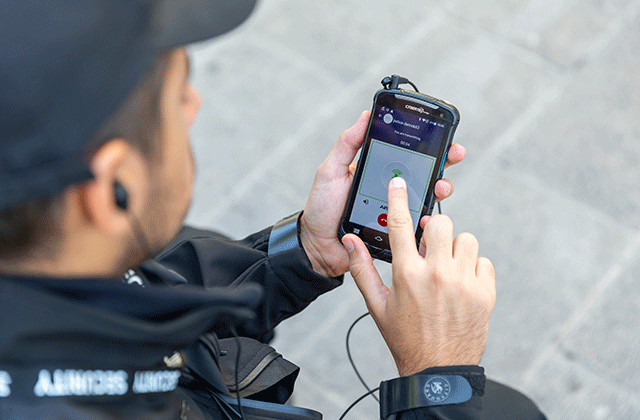
There are also smart push-to-x solutions, such as Tactilon Agnet. These allow professional smartphone users to share rich information instantly with a defined group of people – at the push of a button.
Some generic PTT applications claim to “turn your smartphone or PC into a walkie-talkie”. They promise to provide near-instant communications at the push of a button. They also claim to offer group calling, and even priorities and emergency calls. But generic PTT apps cannot deliver everything a professional user needs. A strong push-to-x app, such as Tactilon Agnet, will do much more to keep you safe.
Did you know?
PTT apps are not just for professional communications: they are a huge part of online gaming. Push-to-talk is commonly used in popular games like Fortnite or Counter Strike. They use a mouse button or a keyboard key as a PTT to interact with and talk to other players.
Using Push-to-talk in these kinds of games prevents unintended keystrokes. It also prevents background noise being transmitted.
Handpicked related content
When choosing a PTT app for professional use, what should you look for? Make sure you get an app that lets you do 17 vital things.
You can also download a handy checklist to use before you decide on your PTT app!
2. Why push-to-talk?
Using push-to-talk, one person can reach a group of people with a single button press. This avoids the need to make several telephone calls. This saves a lot of time - and can even save lives.
A professional PTT solution can offer many other advantages. For example, Tactilon Agnet allows radio and smart device users to communicate in the same groups. This means that smart device users can become part of the professional communications.
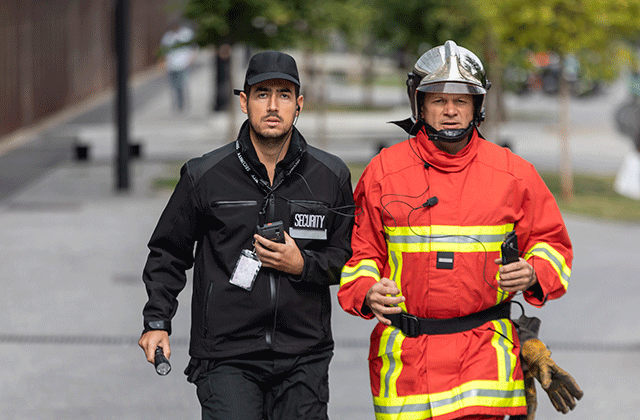
Tactilon Agnet also offers tools for managing users and groups in a secure, professional way. The control center or authorized team leaders can also add people to teams quickly – these new members can then communicate right away.
3. Can a smartphone be used as a walkie talkie?
Yes, a push to talk smartphone app can turn your smartphone into a walkie talkie – in a way. But if you want a PTT app for professional use, you will want more than this.
You will want a variety of communication methods – everything from instant MCPTT to sharing videos and location. The PTT smartphone app must work across technologies. It must also connect with everyone and any data needed in an operation. It also needs to be secure. Your organization also needs professional tools for managing users and groups. For example, Tactilon Agnet is such a solution for smart devices.
There is also a special smartphone that is a walkie-talkie - it is both a PMR and MCPTT device. Tactilon Dabat is a smartphone and TETRA radio in one. It delivers intelligent smartphone features. Some of its features were previously only available on professional radios.
4. How to recognize a professional push-to-talk app?
“What is the best PTT app” is one of the most popular questions.
You must have seen PTT applications that claim to “turn your smartphone into a walkie-talkie”. These generic PTT apps promise a lot. These include near-instant communications at the push of a button. They also offer group calling, and even priorities and emergency calls. Yet, a generic PTT app will not deliver what a professional user really needs.
Don’t be fooled by smartphone walkie-talkie apps. A smart PTT app does much more to keep you safe. Make sure you get an app that provides the key requirements and lets you do these 17 vital things.
5. Does push-to-talk come with video?
Professionals will need to use video, images, and other data in their duties. This means that the information needs to be integrated into their operational communications. The way to achieve this is through an advanced, smart PTT service such as Tactilon Agnet. It provides strong multimedia capabilities to use on smartphones, tablets, and desktops. It also does it reliably and securely. These capabilities include:
-
- private video calls
- real-time video streaming to a group or dispatchers
- dispatchers can display several video streams in parallel
- voice calls and messaging can be performed on top of live video
- HD video streaming with dynamic bitrate control
- video with location information can be streamed either from a mobile device or a body camera
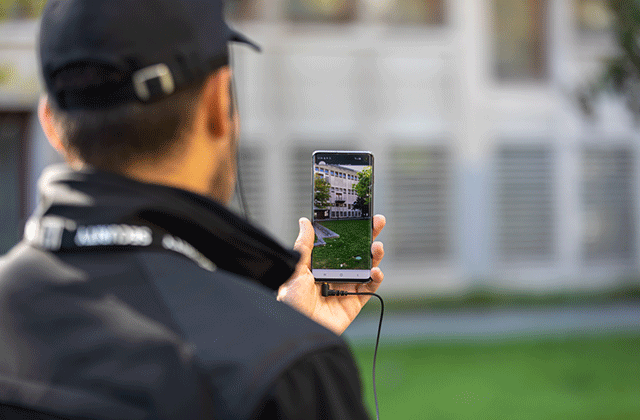
Watch this video to learn more about sending or receiving real-time video with Tactilon Agnet!
6. Does push-to-talk use data?
Professional operations may often need to use video, images, and location coordinates. Professionals need to exchange this information easily and in a controlled way.
The way to achieve this is to use an advanced, smart push-to-talk service such as Tactilon Agnet.
Designed for mission-critical users, this push-to-talk and messaging service allows the transmission of many different types of information. This includes data, video and voice between team members using different devices. These devices can include radios, smartphones, tablets, and laptops.
Tactilon Agnet can integrate with third party applications. This allows you to use external data, such as traffic reports or weather forecasts.
7. What are push-to-talk devices?
Most push-to-talk devices are digital narrowband radios and analogue walkie-talkies. But a smartphone can be a push-to-talk device if it runs a PTT app, such as Tactilon Agnet. Some PTT apps can be used with several smart devices and with Android or iOS. The apps can also run on laptop and desktop computers.
8. Does a push-to-talk app work between iPhone/iOS and Android?
It is possible for a PTT app to work between iPhone and Android. For example, the smart MCPTT app Tactilon Agnet 500 will work on most smart devices that use Android or iOS operating systems. People in communication groups can use any device technologies. The groups can even include narrowband radios.
9. Can a PTT app connect your smart device to a radio?
Choose a smart MCPTT app and your phone can work like a two-way radio.
For example, Tactilon Agnet is a smart MCPTT app or rather a smart push-to-x solution. It brings instant professional communications to the smart device. Radio users and smartphone users can use the same communication groups. This means smartphone users can join professional communications. Previously, a special two-way radio was needed.
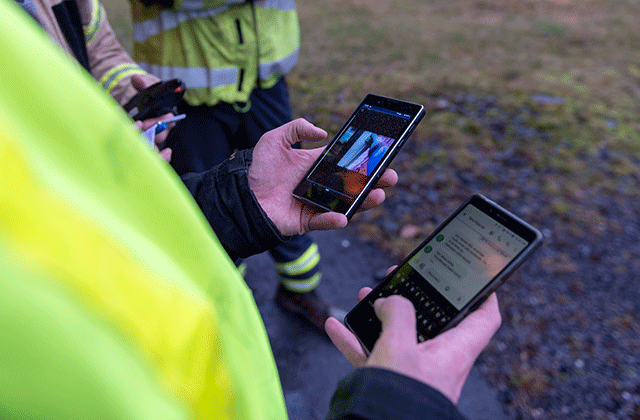
Tactilon Agnet can instantly connect the staff needed on an operation. It can do this even when they use different devices and technologies. Important data and information will reach them quickly, reliably, and at any time.
10. What are push-to-talk accessories?
The right push to talk accessories will help make your MCPTT app more comfortable to use. To use group communications for work, you will need the PTT app on your smart device through your entire work shift. It is important that the app is easy to access and use.
You may need wired or Bluetooth headphones, earphones, or an external PTT button. You might need robust, waterproof equipment or an accessory that is custom-fit for a special use.
When selecting PTT accessories, consider how the accessory will perform in your working environment. Another consideration is appropriate certification. For example, working in hazardous environments means that the accessory must be ATEX certified. ATEX certification proves that the accessory is suitable for use at oil and gas platforms, petrochemical facilities, steel plants, refineries, and harbors. Choosing the wrong accessories can lead to dangerous situations.
Professional PTT apps will have a selection of accessories and gear that have been tested to work well with the app. See the accessory catalogue for Tactilon Agnet, for example. The filters will help you find the right accessories to complement the app.
11. How does push-to-talk work?
To use push to talk on a smartphone, you need a PTT app. Push to talk means that you click and hold down the special PTT button to speak to your team. You keep the button pressed down while you are speaking. A PTT call is the best, quickest way for a group of people to communicate.
A strong, professional MCPTT app such as Tactilon Agnet is in fact a push-to-x or MCX app. It will bring instant professional communications to the smart device. As well as voice calls, it gives professional smartphone users reliable access to video, multimedia, files, and location information. It gives instant, secure sharing with a defined group of people at the push of a button.
Did you know?
A secure PTT app does not have to be difficult to use. For example, see how the Tactilon Agnet MCPTT app works:
Want to learn more? Watch a free online demo of the Tactilon Agnet 500 variant! Or request a free 30-day trial to see the power of Tactilon Agnet 500 for yourself. There is no commitment or credit card information required.
12. How long does it take for push-to-talk to connect?
The connection time for push-to-talk apps depends on the network. Mission critical push-to-talk will usually connect in less than 0.3 seconds. When you push the PTT button on the screen, a good app will make a sound indication when the connection is ready. Start speaking after the sound and you can know that the whole group will hear you.
The sound indication is especially important in mission critical broadband and in heavy communication traffic. Mission critical broadband implements priorities. If the system is congested, higher-priority users – the field commanders during an incident, for example – will have preference in the network. So the small sound will also let you know when you have the connection.
13. What are typical push-to-talk use cases?
“What is push-to-talk used for” is a common question. The best push-to-talk solution for you will work the way your operations require. This means you won’t have to re-design your operations to match the limited capabilities of a simple PTT solution.
The most common use case for push-to-talk is sharing information quickly between a certain group of people. For example, a team working on a task together. In public safety, push-to-talk is important for giving instructions or commands to a team.
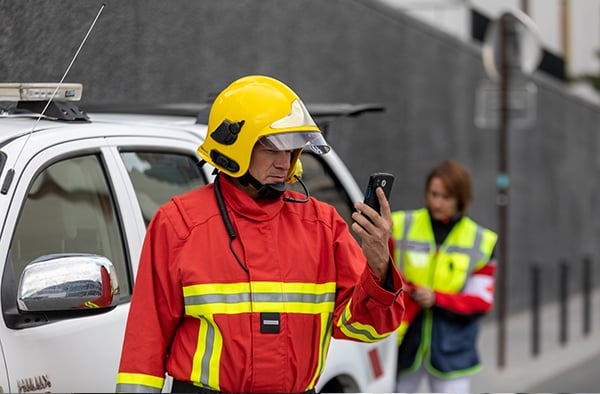
The power of push-to-talk is that it is group communication. Everyone in the group gets the information at once. Giving one short announcement to a group of 15 people is better than calling everyone separately.
Push-to-talk or MCPTT apps allow teams to share other kinds of information in the same way. These can include map locations, video and textual information. In the future, even richer information might be shared.
Another use case for push-to-talk is an emergency call – this is also called a red key call. A person in distress only needs to press or click on the emergency or red key button to get help. The call gets highest priority in the system, allowing the team to act quickly.
Think about if a generic PTT app would meet your professional requirements. After all, a simple push-to-talk app is just that - simple. When your tasks and operations are not always simple, you will need a solution that can meet your operational needs. If the solution does not match your needs, your organization will have to change the way it works to be able to use it.
A strong push-to-talk app, such as Tactilon Agnet, does much more depending on your organization’s own operational needs. It lets you connect other applications into it, allowing even more possibilities for users. This blog post gives you three fascinating examples of how apps could help you work better.
14. Does push-to-talk offer priority access for mission-critical communications?
Priorities are important because they help make sure that the right people can communicate when they need to.
Although broadband technologies can manage traffic load in a congested network, consumer networks rarely use them. Consumer networks treat all subscribers equally, and everyone gets best-effort service. This works well when there is more capacity than the subscribers need.
But when the load gets heavier, everyone gets the same low-quality service.
In mission critical broadband, priorities can be used. The most critical subscribers and the most critical applications can get the highest priority.
A strong PTT solution will also implement priorities. For example, dispatcher can have a higher priority and pre-empt existing transmission. So, you will want to use a strong PTT solution such as Tactilon Agnet because it supports priorities.
Handpicked related content
Don’t be fooled by simple smartphone walkie-talkie apps. A strong PTT solution will do much more to keep you safe. Make sure you get an app that delivers on the key requirements and lets you do these 17 vital things.
Or learn more about how to ensure that public safety users and public safety apps get the service they need - download the executive briefing “Managing priorities in LTE networks”.
15. Is push-to-talk secure?
Mission-critical users need their communications to be always available and secure. They need to exchange information without fear of interception and leaks. Popular push-to-talk apps in smartphones can be used to talk, send text, share documents, pictures or video to a group or to one person. What about PTT app security? Are PTT apps secure?
All professionals should be careful about the tools they use to share information.
Downloading a commercial (often free) app from a generic app store is not a good way to adopt a professional app. Free apps may be okay for personal use, but they are not suitable for professional users. They need a real push to talk solution.
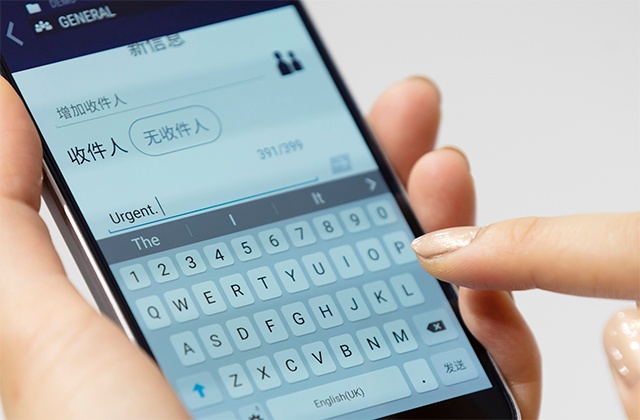
With a PTT solution designed for security-conscious professionals, like Tactilon Agnet, your data and information are safe. The solution encrypts the communications. It also ensures users and talk groups are managed securely. All activities are also logged.
In addition to data security, Tactilon Agnet provides many features that improve its user’s personal safety. Because every second counts in a risky situation, this app has a special emergency button. Pushing the button will call for immediate assistance. And if people work alone, they can have the Lifeguard function to keep them safe. This advanced ‘man-down’ feature will send a high-priority alert if the lone worker should fall and stop moving.
Handpicked related content
Learn more about the security threats related to smartphones - download the white paper “How to manage smartphone risks for professional users”.
Or watch these webinars to get important tips about communication security: ”9 easy ways to improve your communication security” or “Avoid the top 9 PTT app mistakes that could threaten your conversation security”.
16. How can we take push-to-talk into use?
To bring push-to-talk into use, you can adopt Tactilon Agnet 500 from Airbus. As a cloud-based collaboration service, it will not compromise the security of your communications or the efficiency of your operations. The app can work on your existing smartphones.
You will only need four things:
-
- A laptop or PC for provisioning and dispatching,
- A wireless broadband service,
- Android or iOS smart devices, and
- Tactilon Agnet 500 subscriptions.
When you’re all set, your users will download the app from AppStore or Google Play into their smart devices. Because Tactilon Agnet is a Software as a Service (SaaS) solution, you won't have to think about hosting or maintenance for the solution.
Why not watch a free 10-minute demo to experience how easy it is to use Tactilon Agnet 500? Or request a free 30-day trial to see the power of Tactilon Agnet 500 for yourself? Choose a plan that works for you. There is no commitment or credit card information required.
Thanks to the Tactilon Agnet MCPTT solution, it's now easier than ever to start enjoying all the benefits of advanced professional communications.
17. Can you use push-to-talk without internet?
Push-to-talk apps run on mobile cellular networks or use an available Wi-Fi network. If the networks are down, they will not work. On 5G networks, when the network is down, smart phones and other devices can connect to each other directly and transfer data. This is called device-to-device communication or D2D. It is based on a Device Proximity Services, or ProSe feature. The downside of ProSe is that the devices must be very close to each other – no further than 100-300 meters apart.
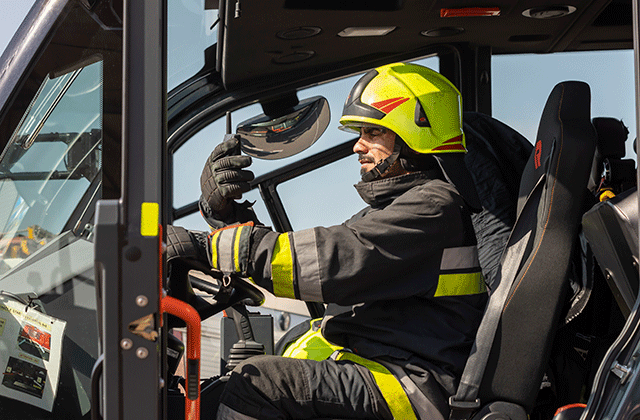 *
*
Push-to-talk radios use a different communication network and they do not need an internet connection. Usually, the radios can connect to each other even if the radio network is down. In TETRA, it is called Direct Mode (DMO). People can switch to DMO when they are close to the edges of network coverage or in remote areas with no network coverage. Firefighters will also switch their radios to DMO when entering a burning building. The DMO range is around 3-5 kilometers.
18. Does push-to-talk work over Wi-Fi?
Advanced push-to-talk solutions such as Tactilon Agnet can use an available Wi-Fi network (and operate over commercial or dedicated broadband networks).
19. Does push-to-talk work without service?
Push-to-talk apps run on mobile cellular networks or can use an available Wi-Fi network. If there is no service because the networks are down, they will not work. See also “Can you use push-to-talk without internet?”
20. What is the range of push-to-talk?
The range of push-to-talk varies. Push-to-talk apps on smart devices will work when they have a network connection – either to a cellular network or to a Wi-Fi network. Narrowband push-to-talk radios work within their network. This can cover an area that ranges from an industrial site to a big city and to a whole country. In addition, radios can stay in contact between themselves.
To work well together, professionals need to exchange information wherever they are located. For example, supervisors may have to manage field personnel who work far away from the main site. A strong cloud-based MCPTT service such as Tactilon Agnet allows people to stay in touch wherever there is commercial mobile network coverage. Their communications will also remain secure.
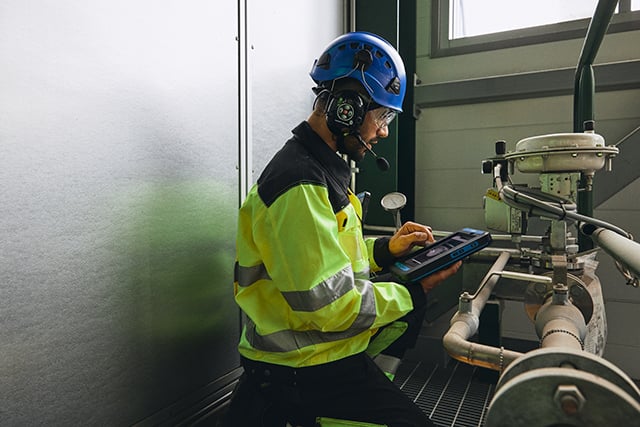
21. What frequency does push-to-talk use?
When you use a push to talk app or a MCPTT app on your smart device, it works on the frequency that your device uses. The exact frequency depends on your country and on your mobile subscription.
For example, the FirstNet public safety broadband network in the US has the frequency allocation of 758-763 MHz / 788-793 MHz. Most two-way radios in the US operate in the 400-500 MHz frequency bands.
In many markets 4G/LTE data is on 700 MHz, 1700-2100 MHz, 1900MHz and 2500-2700 MHz bands.
5G can be implemented in low-band, mid-band, or high-band millimeter-wave, from 24 GHz up to 54 GHz. Low-band 5G uses a similar frequency range to 4G cellphones, 600–900 MHz.
Push-to-talk narrowband radios work on the frequency bands that their networks operate on.
For example, the European TETRA networks use the 380-430 MHz frequency bands. The TETRA networks in the Asia Pacific region use the 806-825 MHz and 851-870 MHz frequency bands.
22. Is it possible to develop a customized MCPTT application?
Strong MCPTT solutions, such as Tactilon Agnet, will offer backend and client Application Programming Interfaces (APIs). They can be customized and they can allow seamless integration with third party applications and accessories – including your existing solutions.
23. Where are push-to-talk servers located?
The location of push-to-talk servers depends on the solution. There are three options when push-to-talk works as a cloud service:
- Public cloud deployment. Public cloud is a platform shared by several organizations (multi-tenant cloud).
- Deployment on a dedicated platform. Dedicated platform means that you can use any data center, just like using a public cloud – the difference is the platform is reserved for your organization’s exclusive use.
- Deployment on in-house servers and your own software licenses.
A strong push-to-x MCPTT solution, such as Tactilon Agnet, is the best way for people to communicate in groups – no matter what deployment model you choose. But did you know that when the service meets five requirements, it can also save you a lot of money? Download this eBook to see how!
These were the 23 most burning questions about push-to-talk solutions and their answers. If you think a relevant question and its answer is missing, please leave a comment to let me know!

